To the folk dances they are cultural expressions that involve choreographed body movements, clothing and music. These manifestations develop a sense of belonging to a certain cultural identity.
Through these popular dances, regional traditions are shared and taught. Thus, these practices become mechanisms for preserving customs and aspects of each culture.
At the Brazil, ethnic-racial diversity, a striking feature of the country, comes from different peoples: indigenous, African and European. This miscegenation process produced different types of manifestations, such as the body practices of folk dances.
Read too: Brazilian folklore — manifestations of our popular culture
List of the main folk dances that exist in Brazil
baião
drummer
Drumming
bumba my ox
cacuriá
green cane
Stamp
catira
foul
Alagoas coconut
congada
Çaire
siriá dance
ribbon dance
papaya ox dance
fandango
frevo
jongo
Lundu
Maralow
Maracatu
sailor
Tootsy
pastoris
pericom
Gang
reisado
samba de roda
samba de matuto
Ticumbi
Xaxado
Xote
Characteristics of Brazilian folk dances
See below the main characteristics of some of the best known folk dances that exist in Brazil.
→ baião
the baião is both a type of dance and a musical genre created in the North East. The main name of the rhythm is Luís Gonzaga, a prominent singer and composer in Brazilian music.
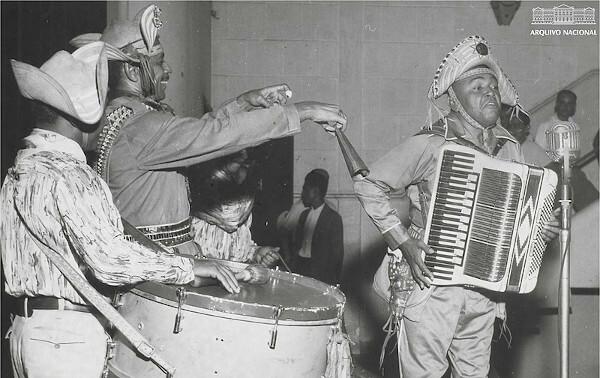
The main influences of the movements were the indigenous dances cateretê or cururu and the African dances lundu, calango and batuque.
in baião, a circle is formed by the public, and the dance is performed in the center, in pairs. The accompaniment is made by the guitar, and the challenges are sung. Among the steps are the heel, the kneel, the twirl and the swing.
→ bumba my ox
O bumba my ox consists of a popular festival that emerged in the Northeast in the 18th century. in the states of North, the name is boi-bumba.
The demonstration involves musical rhythms, theatrical performances, instruments, specific clothing and dance movements. The syncretism of the party mixes elements such as the June saints, the orixás and magical beings.
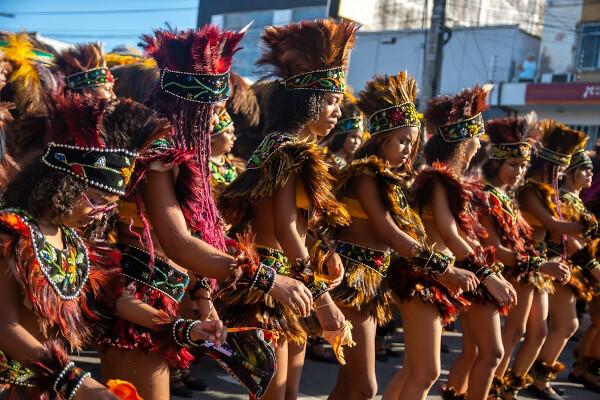
Staged dance and choreography are based on the auto do boi, a narrative that gave rise to the tradition. The popular tale tells the story of an ox that was sacrificed to satisfy the desire of an enslaved woman. In the end, he is resurrected, and the farm owner throws a party as a way of thanking him.
The practice is considered Intangible Cultural Heritage of Humanity by the United Nations Educational, Scientific and Cultural Organization (Unesco).
See too: Folia de Reis — a popular Catholic festival and tradition celebrated in some states of Brazil
→ green cane
The green caninha is a dance of Portuguese origin that arrived in Brazil during the sugar cane cycle. It has had repercussions over time in sugarcane regions, from South to the Northeast. In some places, it is part of the fandango tradition. At the Ceará, manifests itself independently.
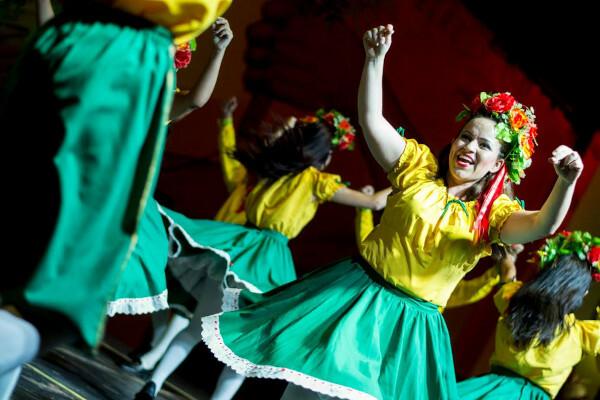
The practice has staging of a popular narrative characterized by the plot of a wedding. The dance consists of two circles, one formed by men and the other by women, who dance in opposite directions. The rotation of places that makes new pairs is done without the participants touching each other. Hand beats are performed when pairs face each other.
Each region has its own particularities.. In Minas Gerais, for example, there is a dance in which the pairs change throughout the entire presentation. The name of this form of dancing is cana-verde-de-passage.
→ Stamp
O stamp is northern manifestation that portrays life in the Amazon region, fishing, agriculture and the narratives of the life of its communities. In the verses and songs, the Amazon imaginary, with its legends and myths, is represented.
The coastal region of For, in Salgado, was the place where the practice began to be developed. Researchers point out that the carimbó was created by the Tupinambá indigenous people. With the arrival of enslaved blacks, tradition gained new ways of manifesting itself. Currently, carimbó is considered Intangible Cultural Heritage of Brazil.

The dancers are barefoot, and the women wear large colorful skirts, blouses that are usually plain in color, and accessories such as bracelets and necklaces made from seeds.
The dance performance is done in pairs. The invitation is made by the men, who go towards the women clapping their hands. The continuous turns made by the pairs were a large circle, which also rotates counterclockwise.
The “Peru de Atalaia” is a moment in the dance in which the men are challenged by their partners to pick up a piece of handkerchief left on the floor in their mouths. If he fails to complete the task, the partner hits his face with the hem of her skirt.
→ catira
Also known as cateretê, the catira is Brazilian practice that began to be carried out at the beginning of the colonial period. The dance is performed in the interior regions of the country, being popular in the states of Goias, Tocantins, Mato Grosso do Sul, Minas Gerais It is São Paulo.
Tap dancing, the central element of catira, is performed to the sound of clapping hands and guitars. It is usually done by a group of people of the same gender..
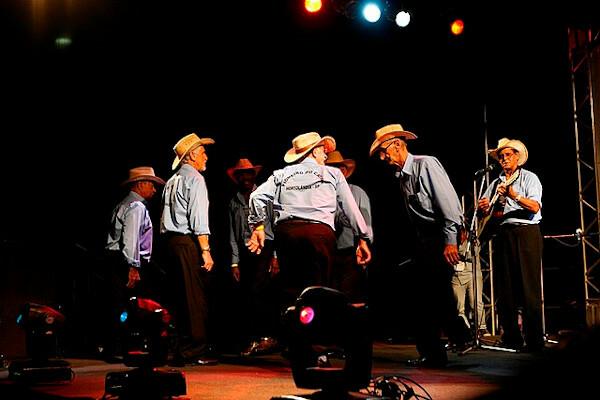
The violist starts the “rasqueado”, and then the dancers perform the “brush”, which means a quick tap of the foot and hand together with six jumps. A part of the viola moda is then sung, and then the guitar player returns to rasquedo next to the dancers' brush. Verses from the viola moda are sung afterwards.
At the end, the participants of the dance perform the “uphill mountain” figure, one after the other, from left to right, stamping their feet and hands. After the turn is completed, they go back and do the same movements in the opposite direction, doing the “down hill”.
→ fandango
fandango is a folk dance that was created in Spain and arrived in Brazil by the Portuguese. The choreography is marked by ballet and tap dancing. Improvisation is an element of dance. Among the instruments used in the presentations are the viola, accordion, rebeca and maxixe.
The types of dances in fandango are known as marks.. Among the fandango brands are the beats, the waltzes and the mixed ones.

In the beat marks, the men who dance do not approach the women and they beat their clogs on the floor. The encounters of bodies in this modality happen in the moments of the bridge, with balances and turns.
In fandango ballet there is no presence of tap dancing. The dancers move together according to the rhythm of the music as in a ballroom dance, with counterclockwise turns.
The simple choreographies, recommended for beginners, are called anu and sinsará. The more complex ones are known as Queromana and Tonta.
→ frevo
O frevo is demonstration thatemerged at the end of the 19th century in the carnival celebrations of Recife, capital of Pernambuco. This Carnival rhythm was influenced by the maxixe, tango, polka, marches and folded.
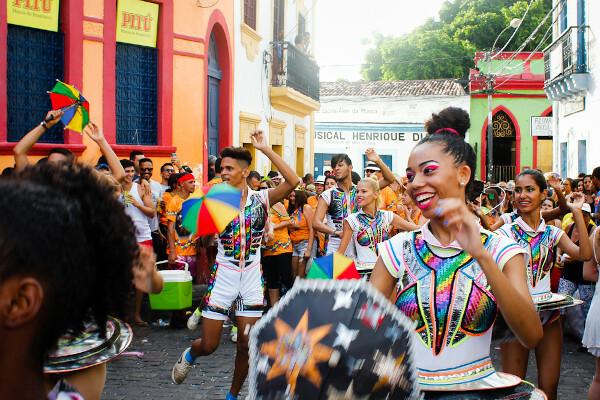
Frevo's body movements were influenced by capoeira. The steps are marked by movements in the low, medium and high planes, with knee flexions. There are more than 100 cataloged dance steps, which mix capoeira, Cossacks and ballet.
In the blocks, the frevo dancers perform more complex movements, which require acrobatic skills.
Know more: What is the history of Carnival?
→ Maracatu
the maracatu emerged in the colonial period and is a popular manifestation that combines music and dance. There is a mixture of African, indigenous and Portuguese elements in this expression.
The state of origin was Pernambuco, in the mid-eighteenth century. This cultural movement is one of the most important in the Northeast.

In the maracatu dance, aspects of the body are important in the execution of the practice. The feet do not drag and move according to the thud. The arms are at shoulder height at most, not allowing them to exceed the face so as not to disturb the vision.
The look is an essential element in maracatu. During the turn, the gaze follows the shoulders. The facial expression shows a smile at this time. During courtship performance, dancers always turn to their audience. The posture of the participants must be marked by an elongated chest, attentive eyes and a smile on their faces.
→ Gang
The gang is one traditional dance of June parties. The origin of this manifestation is associated with the Aryan and Roman peoples of Old age. Over time, with the influences of Catholic church, the practice began to honor patron saints, such as Saint Anthony, Saint John and Saint Peter.
The name was chosen because in the old days it was danced with four or eight couples who formed a square. At the moment, the dance is formed by couples who form a large circle. The clothing is characterized by a redneck outfit.

The script is composed of different types of steps that lead to the dance., such as the horse dance, look at the snake, look at the rain, change partners, path to the fields, tunnel, snail, the big wheel, among others.
In the gang, there is also the realization of the traditional redneck wedding, composed of a theatrical performance during the June festival.
Know also:Feast of June
→ samba de roda
the samba de roda has African roots and began to be held here in Bahia, especially in the Recôncavo Baiano region. The instruments used are the tambourine, the cymbal and the viola.
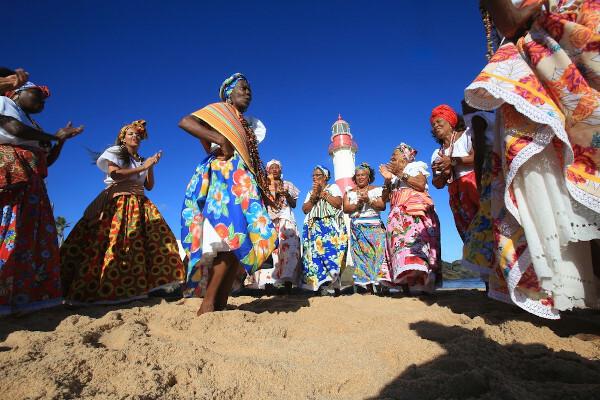
Among the characteristics of the samba de roda choreography are the wheel, the umbigada and the miudinho. In the circle, there are musicians and people who sing in chorus and clap, waiting for the moment to individually enter the center of the circle. Women predominate in samba de roda dancing.
The navel is the signal for choosing the next one to dance, performed by the meeting of the bodies in their ventral regions.
Miudinho is done with short movements with the feet, almost imperceptible, without leaving the ground. Other steps are the jackfruit cutter, mistletoe separator and fire catcher.
The samba de roda from the Recôncavo Baiano was the first Brazilian cultural heritage recognized by Unesco, in 2005.
World folk dances
Folk dances are part of the diversity of cultures from all continents of the world. See below some types of dances present in the world:
adumu, na Kenya It is Tanzania;
cumbia, na Colombia;
footwork, us U.S;
hopak, na Ukraine;
kathakali, na India;
ote’a, in French Polynesia;
zaouli, na Costa do Marfim.

image credits
[1] Joa Souza / Shutterstock
[2] National Archives / Wikimedia Commons (reproduction)
[3] Erica Catarina Pontes / Shutterstock
[4] Guaramiranga Cultural Map / Guaramiranga City Hall (reproduction)
[5] Francisco Braz / Wikimedia Commons (reproduction)
[6] Cristina Gallo / Ministry of Culture / Wikimedia Commons (reproduction)
[7] National Historical and Artistic Heritage Institute (reproduction)
[8] Elysangela Freitas / Shutterstock
[9] Erica Catarina Pontes / Shutterstock
[10] Cacio Murilo / Shutterstock
[11] Joa Souza / Shutterstock
[12] photos / Shutterstock
By Lucas Afonso
Journalist
Source: Brazil School - https://brasilescola.uol.com.br/folclore/dancas-folcloricas.htm
